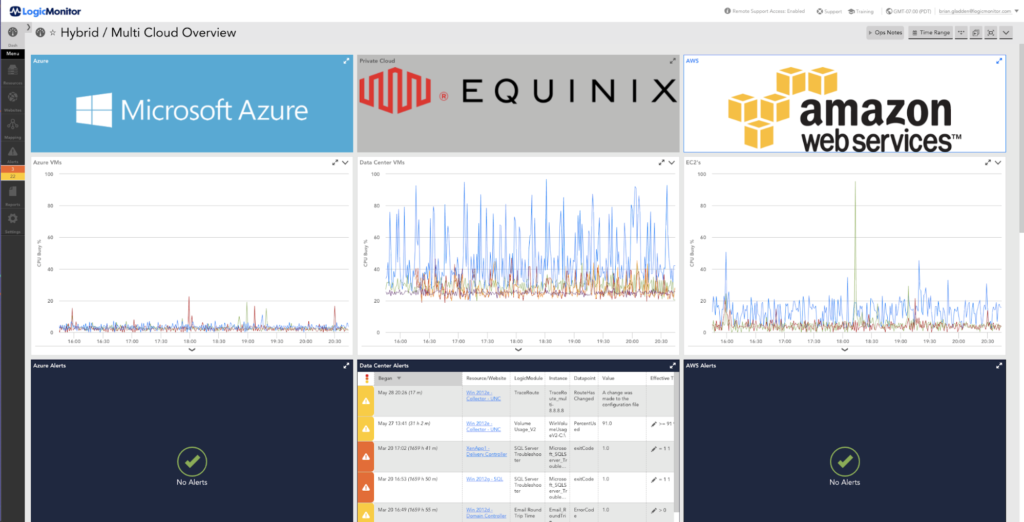Cloud Infrastructure Means Shifted Responsibilities

LogicMonitor + Catchpoint: Enter the New Era of Autonomous IT

Proactively manage modern hybrid environments with predictive insights, intelligent automation, and full-stack observability.
Explore solutionsExplore our resource library for IT pros. Get expert guides, observability strategies, and real-world insights to power smarter, AI-driven operations.
Explore resourcesOur observability platform proactively delivers the insights and automation CIOs need to accelerate innovation.
About LogicMonitor
Get the latest blogs, whitepapers, eGuides, and more straight into your inbox.
Your video will begin shortly
The shift to cloud infrastructure does not remove the need for infrastructure management and administrators but rather necessitates a shift in their responsibilities. Cloud infrastructure has grown to be a ubiquitous part of the modern software industry. This is an amazing growth when you realize that Amazon did not announce Amazon Web Services, starting with Elastic Cloud Computing (EC2), until 2006. In under 15 years, a fledgling software infrastructure concept has grown to be an over $225 billion (USD) industry. This information comes before the current atmosphere has driven more companies to quickly adapt and accelerate their timelines to move to the cloud.
There are two ways to move to the cloud. The first is to use a simple “lift-and-shift” model which almost exactly mimics on-premise infrastructure. All of your applications, network, and storage infrastructure will be moved directly on to the cloud, replacing your on-premise infrastructure with cloud services designed to mimic said on-premise setups. For these, infrastructure management professionals simply transfer their knowledge of on-premise maintenance and monitoring to these cloud services. They are also able to hang up their wire cutters and crimpers to no longer walk into a server room like this:

The other way to transition to the cloud is more complete and asks more of an organization. Adopting a cloud-native approach to transitioning to the cloud will put a lot of pressure on an organization to change rapidly. The requirement is for all infrastructure engineers to start learning how to leverage cloud services to replace aging software infrastructure. They will be asked to help the software developers redesign and restructure the codebase. A good way to kick start this transition is to work with a Managed Service Provider (MSP) to help in the transformation.
As the shift to the cloud starts, infrastructure experts are asked to work hand in hand with development teams to think through the cloud infrastructure as it relates to developer and software needs. This growth continues during the transition and allows more ownership of the entire lifecycle of development to belong with the development team while also offering more early intervention for infrastructure professionals. The skills and expertise of running infrastructure on-premise will help these individuals understand the overall structure of a production environment and guide the decision making.
These new roles also offer greater understanding and visibility to the whole technology side of a business. The greater visibility often leads to streamlining and reducing costs by understanding inefficiencies and the needed scale. The clarity and awareness of this cloud infrastructure can be easily understood and improved upon by the existing infrastructure team as they grow in their new roles. Leaning on their experience, a company can start defining its operation goals and planning for growth.

Working with IT Operations and Development teams to determine the needs and goals of cloud infrastructure becomes the next main target. The experience and expertise of the infrastructure professionals will help to guide the error budgeting needs of critical infrastructure. Meanwhile, they can partner with the development teams to continue to define the processes of moving to cloud infrastructure. These goals will help drive the business in a maintainable and secure way to the cloud. Often these goals will lead to a desire for stability and flexibility, leading to the adoption of multi-cloud infrastructure.
Multi-cloud infrastructure comes out of the desire to not be locked into a single point of failure and the desire to leverage different offerings. Growth in a multi-cloud infrastructure necessitates the growth of infrastructure engineers, as well as the development teams, to learn these new technologies. This growth continues to motivate understanding of the whole software lifecycle and promote unity for the entire organization. As the operational goals are adopted, the next step becomes the ability to monitor the infrastructure’s performance around these goals.
The ability to monitor these performance goals and infrastructure becomes the main goal of infrastructure operators in the cloud. The ability to understand multiple environments and support all levels of cloud growth are vital. As the infrastructure teams reach further into the software development lifecycle, they will want an ability to track and help support the development team. Similarly, the development team will want to be able to understand the performance of their software development lifecycle as well as the production performance of their infrastructure. Having a unified platform to view all of this information and set and track goals become a joint responsibility.

The need is to have a simple, unified monitoring system for infrastructure on-premise that can grow with a company as it adds cloud infrastructure. As a company grows through hybrid on-premise and cloud infrastructure to a full multi-cloud infrastructure, being able to monitor it all is important. Setting maintaining and monitoring goals through the growth stages of a company is critical to the trust of cloud infrastructure and cross-team belief and growth.
If you are ready to discover truly helpful monitoring as your company goes through these growth stages, try LogicMonitor’s platform to gain insight into the performance of your environment. The multitude of infrastructure we monitor will help infrastructure engineers and development teams grow to fully scalable cloud teams. Try it free, or book a free demo today.
© LogicMonitor 2025 | All rights reserved. | All trademarks, trade names, service marks, and logos referenced herein belong to their respective companies.
